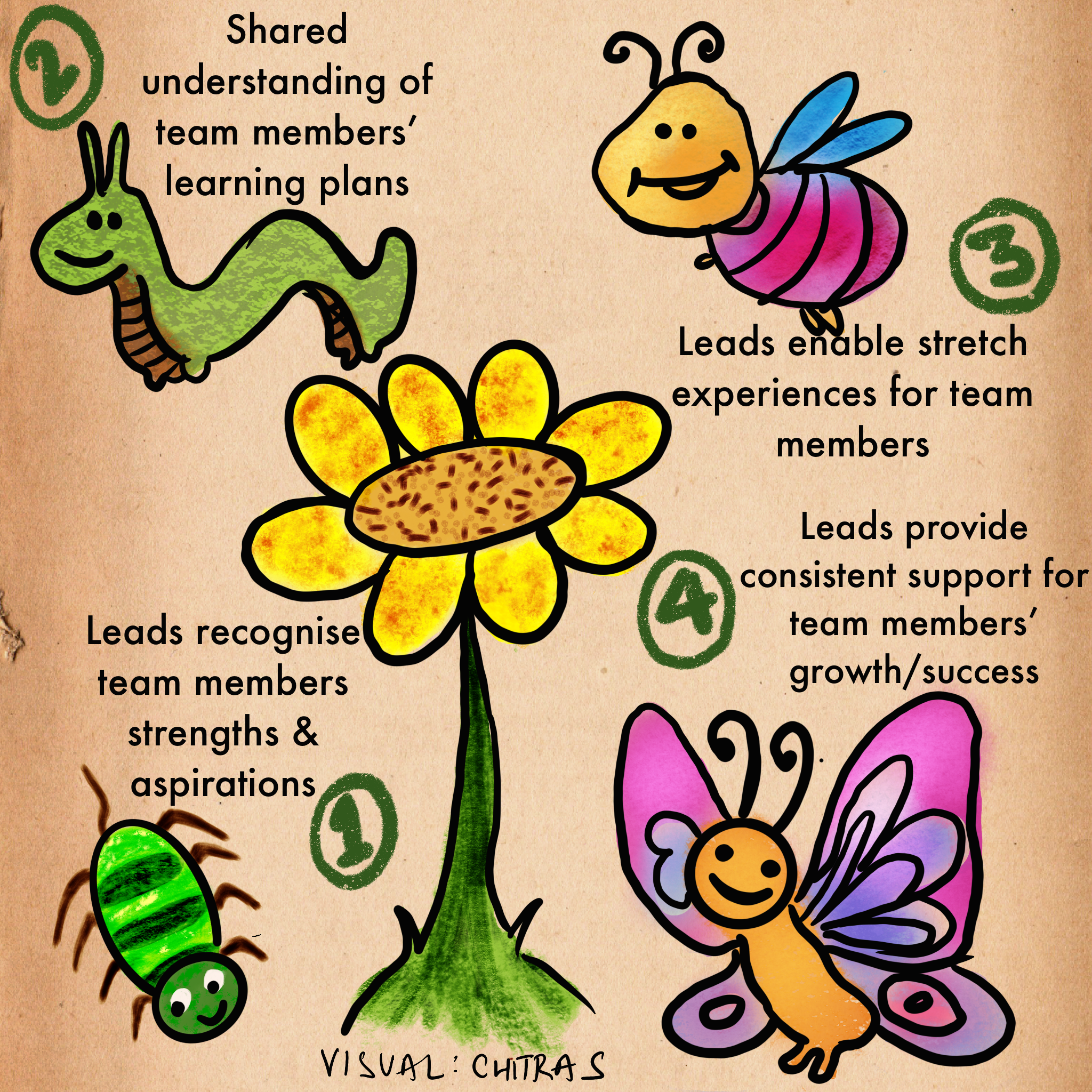Spotting & nurturing potential as a way of life
How can you make spotting and nurturing potential in your team members a way of life.

In our article on What a Cultivation Culture looks like, we shared the 4 main components of a culture of cultivation. One of these components, is that "spotting & nurturing potential is a way of life" in this culture.
We described this component at a meta level in the above article. In this post, we describe it in more detail. This aspect is the spine of the butterfly model of a team lead’s role that we discussed in another article. Think of these as "results" that you would look to create on your team as a leader, to enliven a cultivation culture. While this component of a cultivation culture places primary responsibility on team leads, it can apply to team members as well.
Results for team leads to focus on
You can use these 4 “results” as anchors when you focus on spotting & nurturing potential in your teams & beyond.

I. Team leads recognise individual team members' strengths, interests & learning aspirations
a.Recognising strengths
This result is first about having a strengths based mindset, which is about the conviction & willingness to find strengths in others. And then, to make it an inherent part of your everyday work to look for strengths in team members. While you can use some tools to identify strengths in a structured way , that’s often just a one time activity. The real skill lies in observing your team members in various contexts & noticing little & significant strengths they have. It’s likely to be fairly easy to do once you are proactive about it. Keep in mind that strengths can be:
- Demonstrated: Traits / skills that are obvious to see & fairly developed in someone. They may or may not be aware of it, but are often visible to others.
- Potential: Traits / skills that you might see little flashes of, but they may either be under-utilised or not fully developed .
While demonstrated skills may be easier to spot, bear in mind that often people are either unaware of how these strengths add value to their ecosystem or they underplay their significance. So it’s crucial to reinforce & nurture them so they can master these even more.
Potential skills need a more keen eye, and this is where you as a cultivator/ team lead need to hone your own ability to spot them.
b. Recognising interests & learning aspirations
While a strengths based development approach is useful, it’s often not enough unless it’s aligned with an individual’s learning aspirations & interests. Being good at something doesn’t always translate into wanting to do more of it.
For example, your team member may clearly possess strengths of organising, planning, stakeholder communication, design & facilitation. She may be known & valued for being highly skilled at managing programs, but that doesn’t necessarily mean that she is interested in that for the future as well. She may find management work draining and may be interested in doing more design & facilitation work instead, because that’s more energising for her. So while it’s useful to recognise her program management strengths, her future development & work needs to be aligned with her aspirations as well.
While recognising strengths in someone relies more on your own skill of observation, recognising someone’s interests & aspirations relies more on focused conversations with the person since it’s often not obviously demonstrated or explicitly stated. Coaching / Mentoring / Development type of conversations often help to create clarity in these areas.
II. There is shared understanding of the team members' learning plans
The team lead & team member must be on the same page regarding the team member’s learning plans. This result is about taking the next step after recognising strengths, interests & aspirations in your team members. It entails:
a. Every team member to create a learning & development plan for themselves based on:
- their self reflection on their strengths, improvement areas & learning aspirations
- feedback & suggestions from their team / mentors / community
- conversations about their strengths, aspirations, improvement areas & learning opportunities with their team leads
b. Regular, semi structured growth & development conversations between team leads & team members.
While the responsibility of creating well thought out plans lies with the team members, the responsibility of proactively supporting both the creation & implementation of these plans lies with the team leads.
Bear in mind, that this isn’t simply about the transaction of creating a learning plan but about building a culture where everyone on the team strives to hone their skills in a rather relentless pursuit of excellence. The end goal is to create value for their teams, clients & organisation while creating fulfilment, achievement & growth for themselves.
We recommend a frequency of once in 3 months for these conversations.
III. Team leads consistently enable optimal stretch experiences for team members
This result is about the team leads enabling growth for their team members in structured & unstructured ways. The learning & growth plan works as a baseline reference for both the team lead & team member in this process.
Optimal stretch here means that the team members are working in a way that, while for the most part they use their strengths & existing skills, there is sufficient challenge involved in delivering their responsibilities so that they keep growing & learning continuously.
We recommend stretching on at least 1 or two dimensions of one’s craft / work. The dimensions may include scale, domain, complexity, core skills, level of responsibility, ways of working etc. At the same time, the stretch work itself is best aligned with the strengths & aspirations of the team member. That way they are likely to remain energised & create impact through the challenge. Stretch doesn’t necessarily mean to focus on an improvement area, it simply means working on something that will challenge the person to hone their skills, and these could very well be skills they are good at but can keep developing.
Enabling optimal stretch experiences for team members include the following (but are not limited to):
- Team members own responsibilities that allow them to use at least 2 to 3 of their strengths
- Team members pick up new responsibilities within the team, which will challenge them, preferably in line with their interests & aspirations
- Team members gain new skills / knowledge or hone existing skills as part of the responsibilities they own
This is a high level list to indicate what optimal stretch means, but it’s not an exhaustive one. So please find your own ways to realise these.
We suggest creating optimal stretch experiences within the everyday work context of the team members, and not as an additional thing they do over and above that. While they can of course find ways to learn new things beyond their project responsibilities, they should be able to realise at least some of their learning aspirations within their project itself.
IV. Team Leads provide sufficient support for team members to learn and succeed on their team
Most team leads naturally do this as part of their everyday responsibilities. But it’s useful to see this as a key piece of work that will multiply your impact in every other area of your role.
Providing support for your team members to both succeed in their current responsibilities whilst also learning & growing, mostly in line with their aspirations, can take many forms.
There are so many creative ways in which leaders support, encourage & nurture their team members that it’s impossible to capture them all in a list. Some examples are:
- Sharing clear feedback with them regularly
- Regular Mentoring / Coaching conversations to help them set performance & learning goals, and then supporting them to achieve those
- Unblocking their progress when they are stuck - this could be by providing an external resource or helping them work through a mental / emotional block
- Finding apt opportunities in the system and connecting your team members with them
- Finding & recommending learning opportunities & resources to your team members.
- Encouraging them to learn by experimenting & trying out new things (delivering conference talks, presenting at community events, volunteering for large scale events organised by ThoughtWorks etc.
Check out our article How to spot & nurture potential in others which details out some of these ideas. And we also invite you to keep finding your own creative ways to support your team members.
Cover Image Credit: Kristine Cinate on Unsplash
Illustration visual: Chitra, Our Culture Cafe




